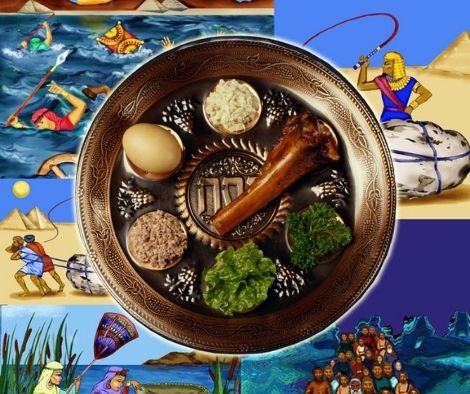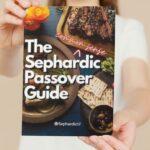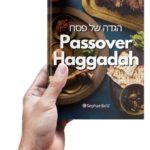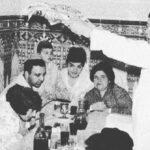About Passover: Celebrating Sephardic Traditions
Passover, known as Pesach in Hebrew, is a cornerstone of Jewish tradition, commemorating the liberation of the Israelites from slavery in ancient Egypt. Rooted in the biblical narrative, Passover holds profound significance for Jews worldwide, symbolizing the journey from oppression to freedom and the enduring faith that sustains the Jewish people through hardship and triumph.
Sephardic Passover Customs: A Tapestry of Cultural Diversity
Sephardic Jews, tracing their ancestry back to the Iberian Peninsula, encompassing Spain, Portugal, North Africa, and the Middle East, infuse the Passover observance with a rich tapestry of cultural diversity and regional customs. Alongside universal elements of the Seder, Sephardic communities add unique traditions that reflect their heritage and identity, enriching the Passover experience with layers of meaning and symbolism.
In Moroccan Sephardic communities, for instance, the haunting melody of “Bibhilu” fills the air as families pass a covered Seder plate over the heads of all present, symbolizing protection from the Angel of Death—a tradition steeped in folklore and faith that echoes the biblical narrative of divine deliverance.
Moreover, Sephardic Passover customs include symbolic reenactments of slavery, such as lightly tapping each other’s shoulders with green onions or scallions, reminding participants of the bitter hardships endured by their ancestors in bondage. These rituals serve as poignant reminders of the resilience and perseverance that define the Sephardic experience.
Diverse Dietary Practices: Embracing Culinary Diversity
Another notable distinction lies in the approach to dietary restrictions. While Ashkenazi Jews traditionally refrain from consuming kitniyot (legumes and grains) during Passover, most Sephardic Jews embrace these foods, adding diversity to their Passover menus. However, it’s essential to note that some Moroccan Jewish families may choose to abstain from kitniyot, reflecting variations within Sephardic practice.
Throughout the holiday, Sephardic Jews also incorporate unique foods and flavors into their Passover meals, such as savory Moroccan dishes and Iraqi delicacies, reflecting the culinary diversity of Sephardic culture.
Engagement with Historical Context: Preserving Heritage Amidst Adversity
To understand the richness of Sephardic Passover traditions, it’s essential to delve into the historical experiences of Sephardic Jews. Following their expulsion from Spain in 1492, Sephardic communities dispersed across the Mediterranean and Middle East, carrying with them a tapestry of traditions that evolved over centuries.
In each new land, Sephardic Jews adapted their Passover customs to reflect their experiences and surroundings, creating a mosaic of traditions that embody the resilience and endurance of their heritage. From the vibrant markets of Istanbul to the sun-drenched landscapes of North Africa, Sephardic Passover celebrations bear witness to the enduring legacy of a people who have triumphed over adversity time and again.
Conclusion: Celebrating Unity in Diversity
In essence, Passover serves as a testament to the enduring legacy of freedom and faith that unites Sephardic Jews across the globe. As they gather around the Seder table, they weave together the threads of their shared heritage, celebrating the triumph of liberation and the enduring spirit of resilience that defines their journey from oppression to freedom, year after year, generation after generation.
| Aspect | Ashkenazi Customs | Sephardic Customs |
|---|---|---|
| Chametz Restrictions | Strict avoidance of kitniyot (legumes, grains, etc.) and other chametz products | Kitniyot (legumes, grains, etc.) are generally permitted during Passover |
| Preparation | Thorough cleaning and kashering of kitchen utensils and surfaces | Emphasis on cleaning and kashering, with regional variations in practices |
| Seder Plate | Includes symbolic foods such as charoset, maror, and karpas | Similar items on the Seder plate, with some variations based on regional customs |
| Matzah | Eaten throughout Passover as a symbol of haste in leaving Egypt | Eaten throughout Passover, with variations in types of matzah and usage |
| Dietary Customs | Strict adherence to Passover dietary laws, including specific kosher certifications | Adherence to Passover dietary laws, with some variations in permitted foods |
| Foods | Traditional Passover foods such as gefilte fish, matzah ball soup, and brisket | Varied cuisine reflecting the diverse cultural heritage of Sephardic communities |
| End of Passover | No specific post-Passover celebration | Mimouna celebration, featuring sweets, music, and hospitality |
Before the onset of Passover, it is customary for Jewish households to conduct a thorough search for any remaining hametz (leavened bread) within their premises. This tradition is rooted in the biblical commandment to remove all leavened products from one’s possession before the holiday begins. The search typically takes place on the evening before Passover, known as “Bedikat Hametz.”
Preparation: Prior to the search, gather a candle, a feather, and a wooden spoon or brush. Some also use a flashlight or smartphone for illumination.
Reciting the Blessing: Begin the search by reciting the blessing: “Baruch atah Adonai, Eloheinu melech ha’olam, asher kid’shanu b’mitzvotav v’tzivanu al bi’ur hametz.” This blessing sanctifies the mitzvah of removing the hametz.
Search Procedure: With the candle or light source, carefully inspect each room, closet, cupboard, and storage area in the home. Use the feather or brush to sweep any crumbs or traces of hametz into the wooden spoon or bag.
Final Check: After completing the search, it is customary to conduct a final check to ensure that no hametz remains. This may involve retracing steps and inspecting areas where hametz might have been overlooked.
Declaration: Once the search is complete, recite the declaration: “Kol chamira v’chamiya d’ikah b’irah d’lo batel v’lo yimatzei, l’hefker k’afra d’ar’a.” This statement nullifies any remaining hametz that may have been overlooked.
Burning the Hametz: On the morning of Passover, any remaining hametz that was found during the search is ceremoniously burned. This act symbolizes the complete removal of leavened products from one’s possession and reaffirms the commitment to observing the holiday’s dietary laws.
Reciting the Blessing: Before burning the hametz, recite the blessing: “Baruch atah Adonai, Eloheinu melech ha’olam, asher kid’shanu b’mitzvotav v’tzivanu bi’ur hametz.” This blessing acknowledges the mitzvah of destroying the hametz.
Disposal: Once the hametz has been burned, it is important to ensure that no remnants remain in the home. This may involve cleaning any utensils or surfaces that came into contact with hametz during the search and burning process.
By diligently performing the search for hametz and burning it before Passover, individuals fulfill the commandment to rid their homes of leavened products and prepare spiritually for the festival of freedom.
As we prepare to embark on the sacred journey of Passover, known in Hebrew as Pesach, we are called to observe timeless traditions that have been passed down through generations. Among these cherished customs is the arrangement of the Seder plate, a symbolic centerpiece that captures the essence of the Passover story. In accordance with the teachings of Sephardic tradition, we meticulously arrange each element on the Seder plate, infusing our celebration with profound meaning and reverence. Let us delve into the significance of each item and the meticulous order in which they are placed, guided by the wisdom and heritage of our ancestors.
The Seder Plate
Maror (Bitter Herbs) – Place the bitter herbs, typically romaine lettuce or endives, representing the bitterness of slavery, on the Seder plate.
Charoset – Arrange the Charoset mixture, made from fruits, nuts, and wine, symbolizing the mortar used by the Israelites in their labor in Egypt, on the Seder plate.
Karpas (Vegetable) – Position a vegetable, such as parsley or celery, representing the springtime and renewal, on the Seder plate.
Z’roa (Shank Bone) – Place a roasted lamb shank bone or a chicken wing, symbolizing the Paschal sacrifice, on the Seder plate.
Beitzah (Hard-Boiled Egg) – Set a hard-boiled egg, symbolizing both mourning and the festival offering, on the Seder plate.

The Seder (Step by Step Order)
| Step | Description |
|---|---|
| Kaddesh | Commence the Seder with Kiddush, using red wine or grape juice. Recite “Shehecheyanu” after the Kiddush, and remember to recline while drinking. |
| Urchatz | Before Karpas, wash hands without a blessing, observing purity laws. |
| Karpas | Dip Karpas into vinegar or saltwater, recite blessings, and consume. |
| Yachatz | Break the middle Matzah, keep the smaller piece, and set aside the larger for the Afikoman. |
| Magid | Begin the Haggadah. The Seder plate is raised, and everyone recites “Ha Lahama Anya”. After “Ha Lahama Anya”, pour the second cup of wine and recite “Mah Nishtanah”. Continue with the Haggadah reading. |
| Rohtzah | Wash hands again, this time with a blessing, in preparation for “Hamotzi”. |
| Motzi Matzah | Say the blessings over the Matzah and consume it. |
| Maror | Eat the Maror (bitter herbs), dipped into Haroset or Haleq. |
| Korech | Make a sandwich with Matzah and Maror, dipped in Haroset, and eat it while reclining. |
| Shulhan Orekh | Enjoy the Passover feast. |
| Tzafun | Retrieve and eat the Afikoman. |
| Barekh – Birkat Hamazon | Recite “Birkat Hamazon” (Grace after the Meal) and drink the third cup of wine, reclining to the left. |
| Hallel | Fill the fourth cup of wine, recite Hallel, and conclude the Haggadah. Drink the fourth cup while reclining to the left. |
| Nirtzah | Pray for acceptance and redemption, and conclude the Seder. |
During Passover, Jews observe special Torah and Haftarah readings that coincide with the holiday’s eight days, including the intermediary days known as Chol HaMoed. These readings, drawn from the biblical texts, are integral to the Passover observance, offering insights into the themes of liberation, redemption, and renewal. Additionally, Shabbat occurring during Passover presents unique readings, combining passages from Exodus, Numbers, and Ezekiel. This table outlines the Torah and Haftarah readings for each day of Passover, along with any exceptions or variations in the readings for Shabbat and other special occasions.
| Day | Torah Reading | Haftarah Reading | Exceptions/Notes |
|---|---|---|---|
| 1st Day | Exodus 12:21-51 | Joshua 3:5-7; 5:2-6:1, 6:27 (Sephardim) | 1st day: Exodus 12:21-51; 2nd day: Leviticus 22:26-23:44 |
| 2nd Day | Leviticus 22:26-23:44 | Jeremiah 31:1-20 | 2nd day: Leviticus 22:26-23:44; 3rd day: Exodus 13:1-16 |
| 3rd Day | Exodus 13:1-16 | Ezekiel 36:37-37:14 | 3rd day: Exodus 13:1-16; 4th day: Exodus 22:24-23:19 |
| 4th Day | Exodus 22:24-23:19 | Isaiah 10:32-12:6 | 4th day: Exodus 22:24-23:19; 5th day: Leviticus 9:1-14 |
| 5th Day | Leviticus 9:1-14 | Samuel 20:18-42 | 5th day: Leviticus 9:1-14; 6th day: Exodus 33:12-34:26 |
| 6th Day | Exodus 33:12-34:26 | Ezekiel 37:1-14 | 6th day: Exodus 33:12-34:26; 7th day: Numbers 28:19-25 |
| 7th Day | Numbers 28:19-25 | II Kings 23:1-9 | 7th day: Numbers 28:19-25; 8th day: Deuteronomy 15:19-16:17 |
| 8th Day | Deuteronomy 15:19-16:17 | Isaiah 10:32-12:6 | 8th day: Deuteronomy 15:19-16:17 |
| Shabbat | Exodus 33:12-34:26; Numbers 28:19-25 | Ezekiel 37:1-14 | Torah reading: Exodus 33:12-34:26; Numbers 28:19-25; Haftarah: Ezekiel 37:1-14 |














Ohr HaChaim Yomi – Emor